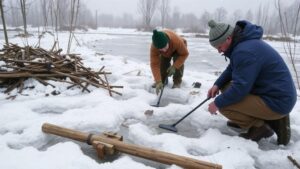Exploring Historical Gold Refinery Sites for Lost Smelting Artifacts
Exploring Historical Gold Refinery Sites for Lost Smelting Artifacts
The study of historical gold refinery sites has emerged as a vital component of archaeological research, offering insights into past industrial practices and technological advancements. These sites, often characterized by remnants of refining equipment, smelting artifacts, and chemical residue, provide a tangible link to the gold rush eras and the advancements in metallurgy. This article explores key historical gold refinery locations, the implications of their artifacts, and the methodologies employed in their exploration.
Historical Context of Gold Refining
The history of gold refining can be traced back to ancient civilizations such as the Egyptians, who were known to refine gold as early as 2600 BCE. As civilizations progressed, particularly during the late 19th century, industrialization and technological advancements transformed gold refining practices. Major gold rushes in locations such as California (1848), Australia (1851), and South Africa (1886) spurred the establishment of numerous gold refineries.
For example, the discovery of gold in Sutters Mill, California, led to an influx of fortune seekers and the establishment of refineries that employed various smelting techniques to extract pure gold from ore. According to the United States Bureau of Mines, California alone produced over 750,000 ounces of gold in 1849.
Identifying Historical Gold Refinery Sites
Identifying historical gold refinery sites requires a multi-disciplinary approach, involving historical research, geological surveys, and archaeological investigations. In regions like the Western United States, researchers utilize historical maps, mining records, and land patents to locate former refinery operations.
- Historical Maps – Old mining maps reveal locations of refineries and associated structures.
- Mining Records – Documentation from mining claims provides insights into refining operations.
The meticulous examination of these records can lead researchers to discover lost or forgotten sites. An illustrative case is the discovery of the Reliez Valley Smelting Works in Contra Costa County, California, which operated in the late 19th century and yielded numerous artifacts.
Methodologies for Excavation and Analysis
Once potential sites are identified, excavation and analysis methodologies must be employed to ensure the recovery and preservation of artifacts. These methodologies include:
- Controlled Excavation: Systematic digging procedures are followed to minimize disturbance and ensure accurate recording of artifact positions.
- Artifact Analysis: Chemical analysis techniques, such as X-ray fluorescence (XRF), can be employed to determine the composition of smelting artifacts.
- Environmental Contextualization: Understanding the environmental conditions surrounding a site helps contextualize the artifacts within historical gold refining processes.
For example, at a site in Julian, California, XRF analysis uncovered high levels of lead in the soil, indicating past refining practices that involved the use of lead-based fluxes, commonly used to separate gold from ore.
Implications of Findings
The artifacts recovered from historical gold refinery sites provide not only a glimpse into past practices but also a broader understanding of the socio-economic dynamics of the time. For example, findings from the Fundy Mine in Nova Scotia have shown extensive use of mercury in the refining process, indicating not only the technological approaches used but also potential environmental hazards of gold refining that persisted long after the operations ceased.
Also, the examination of refining artifacts contributes to the knowledge of labor practices, local economies, and the overall impact of resource extraction on communities. According to the Australian Institute of Mining and Metallurgy, historical gold refining operations were often labor-intensive, which influenced the demographic shifts in various gold rush areas.
Challenges in the Field
Exploring historical gold refinery sites poses inherent challenges, including potential regulatory hurdles, site preservation issues, and the ethical considerations surrounding excavation. Environmental laws may restrict digging activities, especially in federally protected lands. Plus, many historical sites are threatened by urban development or natural erosion, complicating conservation efforts.
Researchers must navigate these challenges while striving to maintain the integrity of the sites. Collaborative efforts with local communities, government agencies, and environmental organizations are essential for successful exploration and preservation initiatives.
Conclusion: Actionable Takeaways
The exploration of historical gold refinery sites offers significant potential for uncovering lost smelting artifacts and enhancing understanding of past gold refining practices. By utilizing historical documentation, employing rigorous excavation methodologies, and addressing the implications of findings, researchers can contribute to the broader discourse on industrial history and environmental stewardship.
- Engage with local historical societies to gather further insights and resources.
- Use modern analytical techniques to enhance artifact analysis.
- Advocate for the preservation of significant sites through collaboration with conservation initiatives.
Ultimately, the study of these historical sites not only enriches archaeological knowledge but also provides critical lessons for current and future practices in resource extraction and environmental responsibility.



